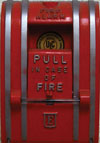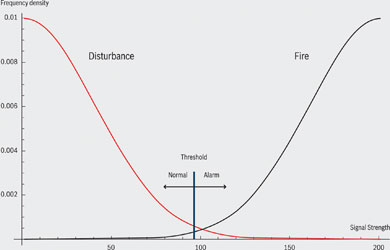

Bosch Security Systems has developed a sophisticated solution to false alarms based on multiple sensor technology.
The incidence of fire detector false alarms in the home and in commercial premises is high. In the UK in 2005, for example, there were more than a quarter of a million false detector alarms causing fire brigade call-out. Most other countries have similar experiences, all resulting in expensive waste of time and money.
Fire detectors are deployed in their hundreds and thousands in a high number of applications and extremes of environment. These extremes range from homes and office buildings with relatively clean and stable airspace, to warehouses and industrial areas with varying degrees of pollution, through to smoky clubs, restaurants and other public places, as well as kitchens with high temperatures.
In cases of genuine alarm, the most frequent cause of triggering a fire detector is the smoke caused by the fire. Because there are many different types of fire depending on the burning material, there are different rates of burning and, therefore, different types and volumes of smoke. The optimal detector should be able to operate with equal efficiency in all fire conditions.
The majority of detectors rely on at least one optical sensor that operates on the scattered light principle. This employs an LED in the measuring chamber where any smoke particles present will scatter the light from the LED. A photo diode then enables an electrical signal to be produced that is proportional to the density of the smoke. The limitation here is that an optical sensor may also provide a detection signal from dust particles, vapour or aerosols that it senses as smoke, thus triggering a false alarm. Some detectors use an ionisation sensor for detection of small-particle smoke. Other types of single-sensor detectors are based on heat or gas detection. Today, many manufacturers of fire detectors offer multisensor models that combine smoke, heat and gas detection. In this case, the combination of optical and heat sensors makes the use of an ionisation sensor redundant.
With modern technology the probability of a false alarm is relatively low, as is the probability of a real fire. Nevertheless, the incidence of false alarms in relation to the number of fire detectors installed in a given system is an important parameter in the choice of detector and its functionality.
Figure 1 illustrates the frequency distribution for false alarm signals compared to those of a real fire.

The diagram shows how an alarm is triggered when the signal level exceeds a certain pre-set threshold level, the minimum setting of which is determined during standard test procedures. The shape of the disturbance curve in the diagram is theoretical. In reality it would drop much more steeply, but is sufficient to indicate the critical point where the two curves intersect in the vicinity of the threshold level.
Determining false alarms
The probability of false alarms is influenced by a number of conditions, or technical measures, usually determined according to industry standards, one such being the EN 54 standard. An additional, non-technical, measure is to reduce the number of detectors in an environment suspected of containing a high level of dust, vapour or aerosol particles. Technical measures include sophisticated signal processing and evaluation of time curves from different kinds of combustible materials in a test situation and comparing with simulated noise signals. In a single-sensor detector, a signal is generated proportional to the density of the smoke or temperature level surrounding it.
Detecting more than one parameter
In test situations and in practice, a single-sensor detector, with its extremes of sensitivity, is more likely to generate false alarms than a multisensor detector. There are, however, situations where a cost-effective single-sensor detector solution may prove adequate – usually in an application where the environment is relatively clean and stable. On the other hand, there is evidence that systems using multisensor detectors have, as a rule, a lower incidence of false alarms than those with single-sensor detectors.
Smoke detection is the most frequently used parameter in fire detectors. Since fire, in addition to different kinds of smoke, also produces gases and causes temperature increase, it is logical that these other parameters should also be detected in order to obtain an optimally reliable method of fire warning and prevention. In the case of heat detection, the detector must be sufficiently close to the source of the fire - closer than if only smoke is to be detected - in order to produce a meaningful signal. This is because, in many cases where a fire is slow-burning, the increase in ambient air temperature is usually considerably slower than the rate at which smoke is produced. Experience shows that the most effective heat detection sensors employ thermistor technology. Some detectors use infra-red to detect temperature radiation but they are mostly used only in specialised applications.
There are many effective fire detectors in use today that employ both smoke and heat sensors. For optimally reliable fire detection, gas detection is often also used together with smoke and heat detectors. The most common gas emitted by fire in an enclosed space is carbon-monoxide (CO), while nitrogen-oxides and hydrocarbons may also be produced, but in smaller amounts. However, CO is not only produced by a burning fire, but is also present in a heavily smoke-laden atmosphere such as that found in a night club with a concentration of cigarette smokers, and in garages and industrial workshops. A single-sensor detector for CO or other gases would mostly only be used in applications where a probability of one of these gases is suspected.
Signal evaluation and classification
Useful signal analysis of all three parameters – smoke, heat and gas – is necessary to determine whether an alarm is false or not. Firstly, in the presence of dust it is likely that the optical sensor will detect this and produce a signal, while the heat sensor and the CO sensor may detect nothing.
For combined optical and heat sensors indicate that with all fire events producing ‘much’ smoke, there is also ‘some’ heat. Conversely, and for most events, where there is ‘nothing’ shown under temperature, there is ‘very much’ smoke. It can therefore be concluded that the combination of an optical sensor with a heat sensor can reduce the incidence of false alarms, especially with noise parameters that have the characteristics of smoke. Most importantly, a detector employing all three types of sensor – optical, heat and gas – is the most effective in reducing false alarms. Such a device is known as an OTC (optical, temperature, chemical) detector.
The Bosch OTC solution
Development engineers at Bosch Security Systems have taken the classification signals and other data to plot a three-dimensional, orthogonal diagram. This demonstrates that all noise parameters are below a certain threshold level and would not trigger a false alarm, while signals from test events are above the threshold and would trigger a reliable alarm. The noise parameters only activating the optical sensor have a significantly lower effect in the overall system. Evaluation of the signals along the time axis allowed a detailed assessment of the overall performance of a theoretical model on which Bosch based the design of its OTC 410 multisensor detector. A further development of this detector is the OTC420 with Bosch’s Local SecurityNetwork improved version (LSNi) bus system technology.
The OTC uses algorithms on a rule-based approach that simultaneously evaluates the spatial distribution and dynamic behaviour of the signals and considers the following criteria before triggering an alarm:
* Rapid increase of signal.
* Constant or fading signal level.
* Increase in temperature.
* Increase in CO concentration.
Assessing the time course allows adjustment of the alarm threshold to the signal increment rate. If the increment rate is steady and typical for a fire, the threshold level will remain unaltered and the detector will trigger an alarm. If the increment rate is rapid and changes abruptly, as with a disturbance signal, the threshold will be momentarily increased. In this case the optical threshold is changed to a less sensitive range to avoid the triggering of a false alarm.
Extended field trials of Bosch’s OTC multisensor detector confirm stable performance in the presence of noise parameters. Now, after a number of years of use in applications of various sizes and types, the OTC has performed even better than expected. Moreover, false alarm rates have been determined by recording differentiated statistics in further extended, critical-condition field trials with a single-sensor smoke detector and the OTC. The OTC reliably suppressed false alarms repeatedly triggered by the single-sensor detector. The superior performance of the OTC is similar to other multisensor detectors in Bosch’s 300 and 500 Series. Outstanding experience with these detectors and further improvements in multisensor technology led Bosch to develop the 420 and 520 Series. The choice of model, possibly including a combination of multisensor and single-sensor detectors, depends on the type and size of application and its environment.
Thorough analysis of the results of several signal parameters of real and false alarm situations in both test and actual conditions clearly provide useful data that helps differentiate between actual fire and false signals. There is ample proof that, in most applications, a smoke, heat and CO multisensor detector will provide more reliable reduced incidence of false alarms than a single- or dual-sensor detector. Bosch Security Systems’ OTC multisensor detector employs state-of-the-art technology to provide superior, cost-effective fire protection in a wide range of applications and environments. The company strives in its development programmes to investigate whether more improvements in detector design can be made that may lead to even further decrease in the incidence of false alarms.
For more information contact Colin Kahn, product manager: Fire Detection Systems, Bosch Security Systems, Sub-Saharan Africa, +27 (0)11 651 9803, www.boschsecurity.co.za
| Tel: | +27 11 651 9600 |
| Email: | [email protected] |
| www: | www.boschsecurity.com/xf/en |
| Articles: | More information and articles about Bosch Building Technologies |

© Technews Publishing (Pty) Ltd. | All Rights Reserved.